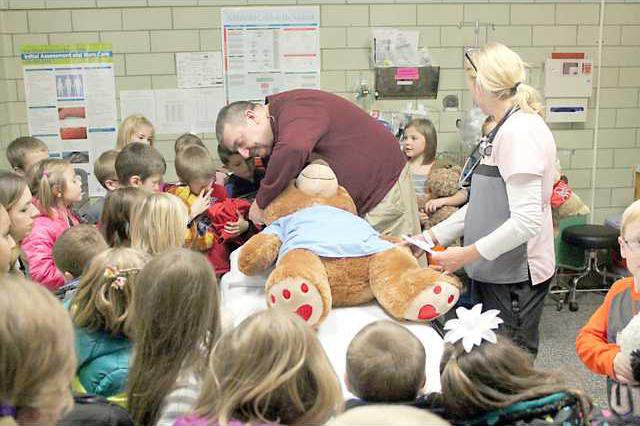Thursday afternoon, Ellinwood first graders from Ellinwood Grade School and St. Joseph’s Catholic School, clutching stuffed toy bears, monkeys, and even a giraffe made their way to Ellinwood District Hospital and Clinic. In celebration of National Rural Health Day, the students were invited to attend a special Teddy Bear Clinic, organized by Lindsey Bogner, Ellinwood District Hospital Foundation and Community Education Director.
Students arrived at the clinic where they met Theodore, a large stuffed bear. Theo would accompany the 35 youngsters on the hospital tour.
“Having rural health care available is so important - it helps our patients, our employees, our businesses, our economies,” Bogner said. “This Teddy Bear Clinic is also a way to show our local students that the hospital isn’t a bad or scary place, that doctors are there to help you feel better.”
Students learned rural means not in a large city. Ellinwood’s hospital is a rural hospital, she explained, and asked the kids why they need a hospital close by. Several hands raised, and one by one, the answers came.
“People get sick.”
“If you have to there fast.”
“You can get hurt really bad on the playground and go there.”
Bogner explained the importance of staying together and being quiet so the patients would not be disturbed, and then it was time to begin the tour. Students visited an examination room, where they met Dr. Chris Brown, you gave Theo his initial checkup. Then, it was time to go to the emergency room, where Theo was diagnosed with a broken hand, and was wheeled to radiology where he was given an x-ray. Students shared their own and family members’ experiences at the hospital along the way. Finally, there was a visit to the lab where a staff technician explained the importance of cooperating and being still while blood is drawn, and students learned about what happens with the samples after they are taken.
With all the lessons they’d learned, it was time for a snack and a chance to play doctor. As students ate cheese sticks and fruit jello cups, they listened to staff members reinforce lessons on hand washing, nutrition and exercise. They dressed up in gowns, latex gloves and masks and visited stations with their stuffed animals, checking reflexes and blood pressure, listening through stethoscopes, and even bandaging the bears.
Hoisington
Earlier Thursday morning, Hoisington’s Chamber Coffee was held at the Turnbull safe room at Clara Barton Hospital. CEO Jim Blackwell spoke about the threat of having to close that rural hospitals are confronted with on a constant basis.
Pawnee County hospital, he said, had narrowly escaped closure only a few years ago, but the rural hospital in Independence was forced to close earlier this year.
“It’s vitally important that people talk to their elected officials and let them know the importance of keeping their local hospitals open, especially in times like these when legislators are looking for places to trim budgets,” he said.
Surgical services and physical therapy are two areas, he said, where Clara Barton is showing its value to the area. Patients from a region spanning from Phillipsburg to Medicine Lodge are opting to have surgeries performed in Hoisington, rather than having to travel long distances to larger urban centers, he said. One attendee spoke up and told of a recent surgery she had undergone at Clara Barton when she pushed her physician to find out if it could be done locally rather than going to Wichita. Blackwell urged others to keep this in mind, to ask the question, “what can be done locally,” because not all providers know.
Scott Fleming, Director of Hoisington’s EMS, applauded the City of Hoisington for supporting the local hospital, and added that Clara Barton Hospital is a level four trauma center, which means it can handle the calls EMS makes locally.
“It’s quite an accomplishment to get and keep that designation,” Fleming said.
City Councilman Brian Wilborn spoke up, and reminded attendees that only a few years ago, the community was on the verge of losing Hoisington’s EMS service, but thanks to the efforts of Scott and several new volunteers, the service has recovered.
“We don’t’ want to have to wait for a truck to come from Great Bend,” he added. “If you know of anyone with an interest in EMS, please ask them to consider volunteering.”
According to the National Rural Health Day website, http://celebratepowerofrural.org, nearly one in five Americans live in a rural community.
These rural communities also have unique healthcare needs. Today more than ever, rural communities must address accessibility issues, a lack of healthcare providers, the needs of an aging population suffering from a greater number of chronic conditions, and larger percentages of un- and underinsured citizens. And rural hospitals – which are often the economic foundation of their communities in addition to being the primary providers of care – struggle daily as declining reimbursement rates and disproportionate funding levels make it challenging to serve their residents.
First and foremost, National Rural Health Day is an opportunity to “Celebrate the Power of Rural” by honoring the selfless, community-minded, “can do” spirit of that prevails in rural America. But it also gives us a chance to bring to light the unique healthcare challenges that rural citizens face – and showcase the efforts of rural healthcare providers, State Offices of Rural Health and other rural stakeholders to address those challenges.





